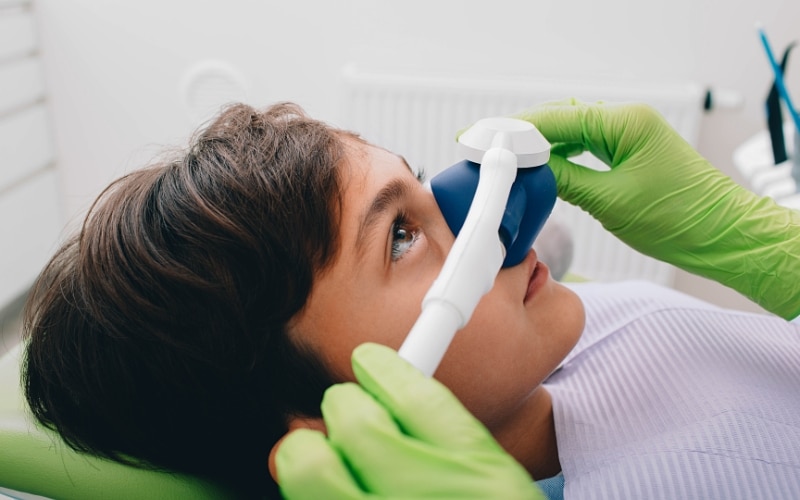Introduction
Many people find going to the dentist to be an anxiety-provoking event. Dental anxiety, whether the fear of needles, dental drills, or simply the discomfort associated with dental procedures, is common. Fortunately, Dental sedation and dental anesthesia are two choices contemporary dentistry provides to patients to help them manage their pain and anxiety.
In this blog post, we’ll examine the distinctions between these two methods to provide the information you need to choose wisely for your upcoming dental appointment.
Understanding Dental Sedation
A. Definition
Dental sedation is a technique used to relax patients during dental procedures. It involves administering medications that help patients remain calm, comfortable, and less anxious while staying awake and aware during the treatment.
B. Types of Dental Sedation
1. Nitrous Oxide (Laughing Gas):
Nitrous oxide is a widely used form of sedation. It is inhaled through a mask placed over the nose, providing relaxation and mild euphoria.
2. Oral Sedatives:
These are prescribed medications taken orally before the dental procedure. Depending on the patient’s needs, they can range from modest anti-anxiety drugs to moderate sedatives.
3. Intravenous (IV) Sedation:
IV sedation is administered through a vein, providing more profound relaxation. Patients often need more memory of the procedure.
C. How Does Dental Sedation Work?
Sedation reduces the central nervous system, reduces anxiety, and induces relaxation. It does not put the patient to sleep but helps them feel calm and comfortable.
D. Benefits and Risks of Dental Sedation
1. Benefits:
Dental sedation helps patients overcome dental anxiety, reduces pain perception, and makes dental procedures more efficient and comfortable.
2. Risks:
Although generally safe, dental sedation can lead to complications, such as nausea, dizziness, or allergic reactions. These risks are typically low and carefully monitored by trained dental professionals.
Understanding Dental Anesthesia
A. Definition of Dental Anesthesia
For the duration of a dental procedure, dental anesthesia includes temporarily losing feeling in a particular location of the mouth or body. It can be localized to a specific tooth or region or induce a state of unconsciousness.
B. Types of Dental Anesthesia
1. Local Anesthesia:
This type is commonly used for minor dental procedures. A local anesthetic is injected into the specific area where the process will take place, numbing the nerves and preventing pain sensation.
2. Regional Anesthesia:
Regional anesthesia is used for more extensive procedures, numbing a larger mouth area, such as an entire mouth quadrant.
3. General Anesthesia:
General anesthesia renders the patient unconscious and unable to feel any pain. It is typically reserved for complex oral surgeries.
B. How Does Dental Anesthesia Work?
Local and regional anesthesia block pain signals by temporarily interrupting nerve function, while general anesthesia induces unconsciousness, completely disconnecting the patient from pain perception.
C. Advantages and Potential Complications of Dental Anesthesia
1. Advantages:
Dental anesthesia ensures patients experience zero pain during dental procedures, making it suitable for extensive surgeries.
2. Complications:
While rare, complications can include allergic reactions, nerve damage, or postoperative pain. Dental professionals take precautions to minimize these risks.
Key Differences Between Sedation and Anesthesia
A. Level of Consciousness
- Dental Sedation: Patients remain awake and aware.
- Dental Anesthesia: Patients can be partially or entirely unconscious depending on the type.
B. Administration Method
- Dental Sedation: Administered via inhalation, oral medication, or intravenous injection.
- Dental Anesthesia: Administered through injections for local and regional anesthesia; general anesthesia is typically administered intravenously.
C. Patient Experience and Awareness
- Dental Sedation: Patients are relaxed and comfortable, with varying levels of awareness.
- Dental Anesthesia: Patients under general anesthesia are entirely unconscious, while local or regional anesthesia only numbs specific areas.
D. Purpose and Use Cases
- Dental Sedation: Ideal for patients with dental anxiety or those undergoing minor to moderately complex procedures.
- Dental Anesthesia: Reserved for extensive surgeries or when complete unconsciousness is necessary.
E. Safety Considerations
Both sedation and anesthesia are generally safe when administered by trained and experienced dental professionals.
Based on the patient’s medical history and the type of treatment, preoperative examinations help choose the best alternative.
Factors to Consider When Choosing Between Dental Sedation and Anesthesia
1. Procedure Complexity:
The complexity of the dental procedure is a critical factor. Minor procedures may require only dental sedation, while extensive surgeries may necessitate anesthesia.
2. Patient Anxiety:
Consider the level of anxiety or fear you experience when visiting the dentist. Dental sedation can help alleviate stress, making the experience more comfortable.
3. Medical History:
Your dentist should be informed of your medical history and any pharmaceutical allergies or sensitivities to ensure the procedure is safe.
4. Cost:
Dental anesthesia is typically more expensive than sedation, so consider your budget.
Regulations and Guidelines Governing Sedation and Anesthesia
Dental sedation and anesthesia administration are subject to strict rules and guidelines to ensure patient safety. Dental professionals must undergo specialized training and adhere to state-specific protocols and standards. These regulations are put in place to protect patients and provide them with the highest quality dental care.
Conclusion
Dental Sedation and Dental Anesthesia are two valuable tools in modern dentistry, allowing patients to receive the care they need comfortably and painlessly.
Choosing the right option depends on various factors, including the procedure’s complexity and your personal preferences.
Always consult with your dentist, such as the experienced professionals at Missouri City Dentist – Excel Dental, to determine the most suitable approach for your dental needs.
You can look forward to a more comfortable and stress-free dental experience with the right choice, ensuring your oral health is in excellent hands.
You can also read our other article on Sedation Dentistry: Sedation Dentistry: Definition, Types & Advantages.


